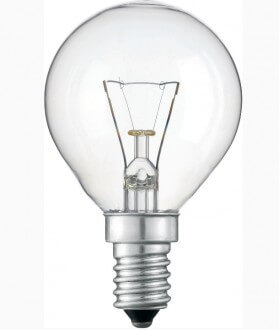Overview of the characteristics of incandescent lamps
 An incandescent lamp device includes a glass bulb containing a tungsten filament and an inert gas (xenon, krypton, or argon). The thread is installed on special supports and electrodes through which electric current passes (you can visually see the structure in the picture above). When screwing the cap into the cartridge, electricity passes to the tungsten filament, which glows and emits light. This is the principle of operation of the bulb.
An incandescent lamp device includes a glass bulb containing a tungsten filament and an inert gas (xenon, krypton, or argon). The thread is installed on special supports and electrodes through which electric current passes (you can visually see the structure in the picture above). When screwing the cap into the cartridge, electricity passes to the tungsten filament, which glows and emits light. This is the principle of operation of the bulb.
Characteristic
The main technical characteristics of an incandescent lamp:
- power range - from 25 to 150 W (for domestic use) up to 1000 W;
- the temperature of the tungsten filament within 3000 degrees;
- light output - from 9 to 19 Lm / 1 W (for example, the luminous flux of a 40 W incandescent lamp can vary from 415 to 460 Lm);
- rated voltage - 220-230 V and 127 V;
- frequency - 50 Hz;
- socle size - 14 mm (E14), 27 mm (E27) and 40 mm (E40);
- service life or simple service life - at a normal voltage of about 1000 hours (220V) and 2500 hours (127 V);
- base - threaded, pin single and double pin.
Technical characteristics of household incandescent lamps:
We figured out the parameters, now let's talk about the varieties.
Varieties
Today there is a wide range of bulbs, which are divided according to the following criteria:
- bulb shape (spherical, cylindrical, tubular, spherical, etc.);
- flask coating (transparent, mirror, opaque);
- purpose (general, local, quartz-halogen);
- flask filler (vacuum, argon, xenon, krypton, halogen, etc.).
Consider the photo and characteristics of the most popular types of incandescent lamps.
Transparent is the most common option. Such products are the cheapest and least effective, because the light flux is scattered unevenly. The lack of transparent flasks is that the light “hits” the eyes. Mirror flasks are more effective, because the coating creates a directional light flux. Such products are popular when lighting shop windows and trading floors.
Mirror flasks are more effective, because the coating creates a directional light flux. Such products are popular when lighting shop windows and trading floors.  Matte make the lighting softer and more diffused, which creates favorable conditions for work and rest when the light is on.
Matte make the lighting softer and more diffused, which creates favorable conditions for work and rest when the light is on.  Local lighting products operate at a voltage of 12-24-38 Volts, which is necessary to create safe working conditions. Such light sources can be used to illuminate the inspection pit when installation of electrical wiring in the garage.
Local lighting products operate at a voltage of 12-24-38 Volts, which is necessary to create safe working conditions. Such light sources can be used to illuminate the inspection pit when installation of electrical wiring in the garage.
Marking
Marking of incandescent lamps has the form: The first letter part is the design feature and physical properties of the product (B - argon bi-helical, B - vacuum, gas-filled mono-helical argon, BK - coiled krypton, ML - in the milk flask, MT - matte flask, O - opal flask). The second letter part is the purpose of the product (F - railway, SM - airplane, KM - commutator, A - automobile, RV - floodlight). The first digital part is the rated voltage and power. The second digit part is the revision number. For example, marking B235 - 245-60 means that the product is bi-spiral, operates at a voltage of 245 V and has a power of 60 watts.
Advantages
The main advantage of incandescent lamps is the lowest cost of products, compared with competitors (LEDs, halogen lamps etc.). In addition, a number of advantages can be distinguished, which are the reason for choosing these light sources:
- They can work normally at low temperatures, due to which they are used atinstallation of street lighting.
- With minor power surges, the product does not fail.
- They work even at very low voltage (only the light intensity will decrease).
- The variety and power of products has a wide range, so you can choose the product that is suitable for certain operating conditions.
- They can function normally with high humidity.
- Connect to the network without additional equipment.
- Surpass gas-charged light sources for safety. If the energy-saving lamp breaks, it is urgent to carry out a set of measures for airing the premises and chemical surface treatment.
disadvantages
The main disadvantage of incandescent lamps is the low light output and the predominance of red and yellow color shades in the spectrum. In addition, there are several more disadvantages:
- The product has a small service life, which is reduced when the nominal voltage deviates from the network.
- The flask is very fragile, therefore, it is used only in combination with a ceiling. We recommend that you read the helpful tip about how to unscrew a broken light bulb.
- Do not save electricity.
So we examined the technical characteristics of incandescent lamps, types and markings. We hope that this information was useful and understandable for you!
Related materials:













